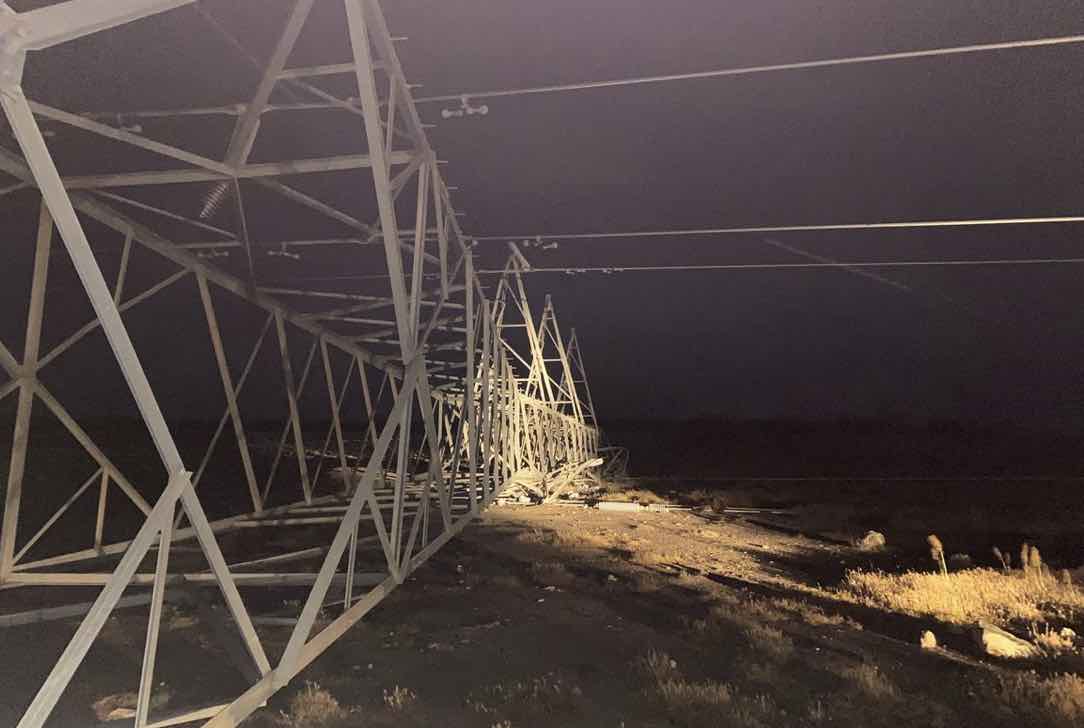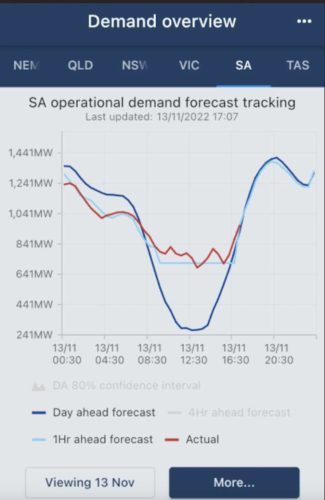Rooftop solar on homes and businesses have been heavily curtailed in South Australia as authorities responded to a rare “islanding” of the state grid after heavy storms brought down at least one transmission tower and caused multiple transmission lines to trip.
On Sunday, it is estimated around 400MW of rooftop solar capacity was switched off to help keep the state grid stable because it had been cut off from the rest of the main grid.
A smaller amount was expected to be cut off on Monday. The dose could be repeated later in the week depending on solar conditions and grid demand.
Large scale wind output has also been cut back, although it is initially unclear how much. Data provide GPE NemLog2 estimated a record amount of 1660MW of large scale wind and solar curtailment at 1.30pm on Sunday, but it is unclear how much of this was directed, or withdrawn by owners because of negative prices.
The incident was sparked on Saturday afternoon when severe storms swept through the state, and a fallen transmission tower near Tailem Bend caused both circuits on a 275kV transmission line to trip, separating the state’s grid at 4.40pm (AEST) from the rest of the National Electricity Market.
South Australia lead world in rooftop solar share
The Australian Energy Market Operator says the South Australia grid – which leads the world in its share of wind and solar (66 per cent of local demand in the last 12 month) – remains in a secure operating state.
However, it has been forced to take action – instructing the cutting off of rooftop solar and curtailment of large scale wind and solar – to ensure it has enough controllable assets to manage the grid and that “operational demand” is kept above a certain threshold.
“AEMO has exhausted all options available to stabilise the power system during these challenging conditions, including grid-scale generation curtailment,” AEMO said in a statement issued to RenewEconomy on Monday afternoon.
“However, these measures have not been sufficient to manage the risk of major supply disruptions. Therefore, the curtailment of commercial, industrial and residential rooftop solar PV is required as a last resort to maintain grid stability.”
It says that electricity supplies to customers have not affected by the fallen tower and the grid separation, although the local network operator, SA Power Networks, says that up to 160,000 people were without power at one stage because of fallen poles and wires in local areas.
Biggest blackout since 2016
SAPN has described the event as the “biggest blackout” since the state-wide “system black” in late 2016, although all the outages this week have been caused by local damage to poles and wires, rather than any system failure.
However, AEMO had to intervene in the market to dial down significantly the amount of rooftop solar PV that is sending power into the grid because the state grid is isolated, and it has also encouraged major users to increase “load” to make the grid more manageable.
South Australia has, at times, had nearly all its domestic demand met by rooftop solar, but on those occasions it is able to send surplus power to Victoria, and it still has enough “controllable” assets to manage the grid.
In an islanded state, and with no exports, that becomes more difficult, and the state does not yet have enough battery storage to deal with such events, so it must run other units, such as gas generators to provide essential grid services. To allow those units space to generate, that means dialling down rooftop PV when needed.
AEMO has also directed some “scheduled” loads into service to soak up excess supply, and has also curtailed some large scale generation. It has also instructed SAPN to switch off solar units within their control to keep the grid in a management state,
On Sunday, SAPN switched off some small (less than 5MW) solar farms (totalling around 20MW) and also new rooftop solar installations that can be easily switched off in such circumstances (around 100MW).
Voltage control used to switch off rooftop panels
SAPN then had to revert to voltage control to switch off up to another 300MW of rooftop solar and then had to turn to social media to ask others to switch off their rooftop solar systems in order to create enough “load” to help AEMO manage the system.
This chart above illustrates the problem. The day ahead forecast for Sunday indicated very low grid demand of around 240MW (dark blue line) – not normally a problem if the interconnector is working. But once it went down, AEMO sought to lift operational demand to around 750MW to make it manageable (light blue line).
SAPN’s intervention – switching off small and rooftop solar – helped lift demand back up to the red line, roughly in line with AEMO’s needs once the voltage control and added requests were implemented. Demand is increased when rooftop solar is switched off because the household, or business, needs to draw power from the grid.
(SAPN insists that the voltage control measures are designed to trip solar inverters only, and should not damage household appliances).
Such measures were expected to be repeated on Monday, although to a smaller extent, but large scale solar switch offs could return later in the week – depending on weather conditions and demand – until the transmission network is repaired the state re-connected to the main grid.
ElectraNet crews inspect fallen transmission tower
In a separate statement, transmission company ElectraNet said its crews and contractors were inspecting the transmission lines that were in path of the storms. It is thought that could take at least a week, meaning the state will be islanded until that time.
“As we mentioned last night, customer supply as a result of the damaged tower at Tailem Bend has not been impacted and we are developing a plan to safely make the required repairs,” it said.
“Until the damaged tower is repaired, power flows to and from Vic are constrained to zero, which will require curtailment of roof top solar to maintain system stability.
“We are liaising closely with the Australian Energy MarketOperator and will continue to closely monitor the state’s high-voltage transmission network.”
Note: The south-east corner of South Australia appears to be connected to the NEM, as the transmission tower that fell is north and west of those facilities, and there appears to be some exchange of power in the MurrayLink line.











